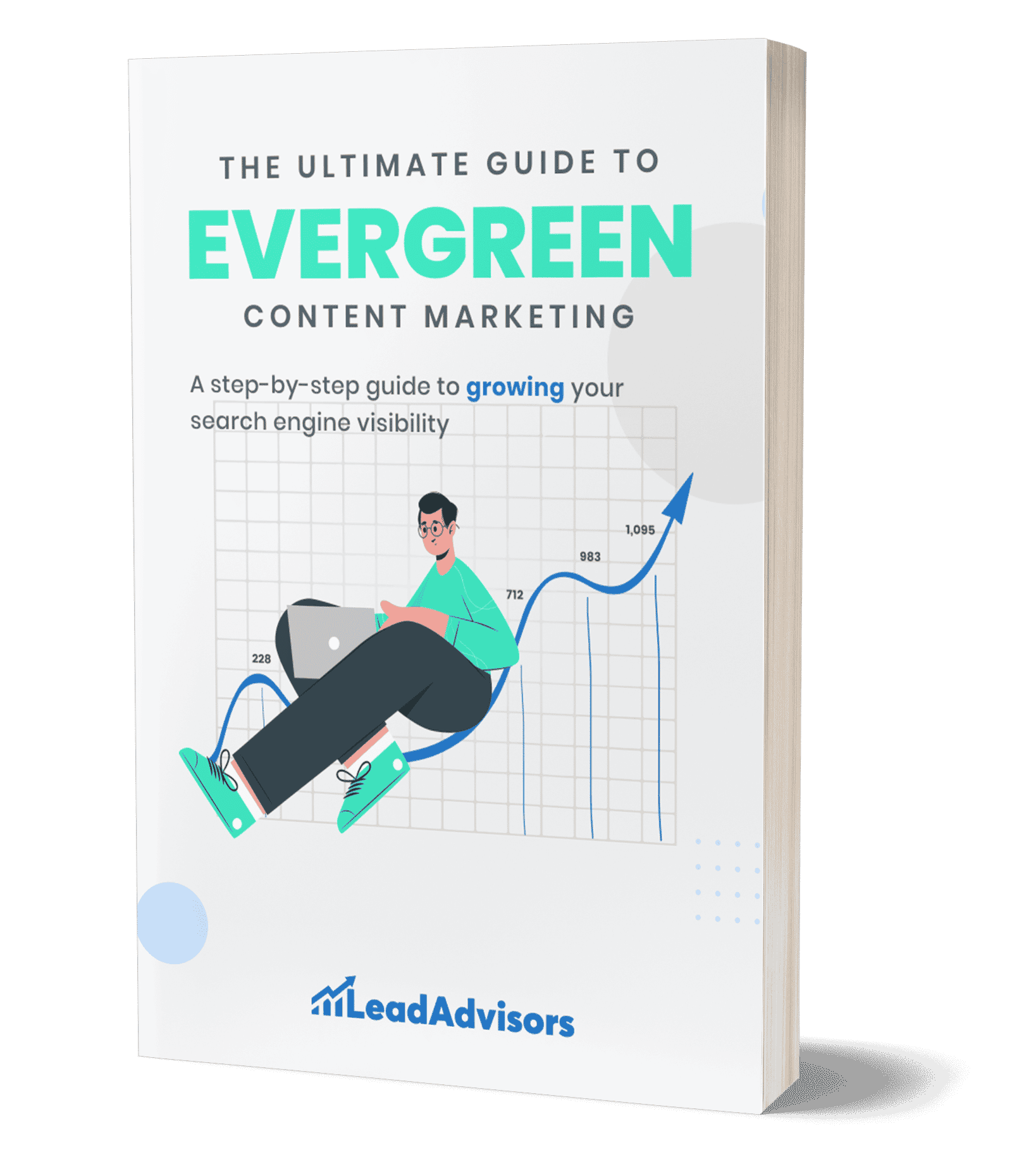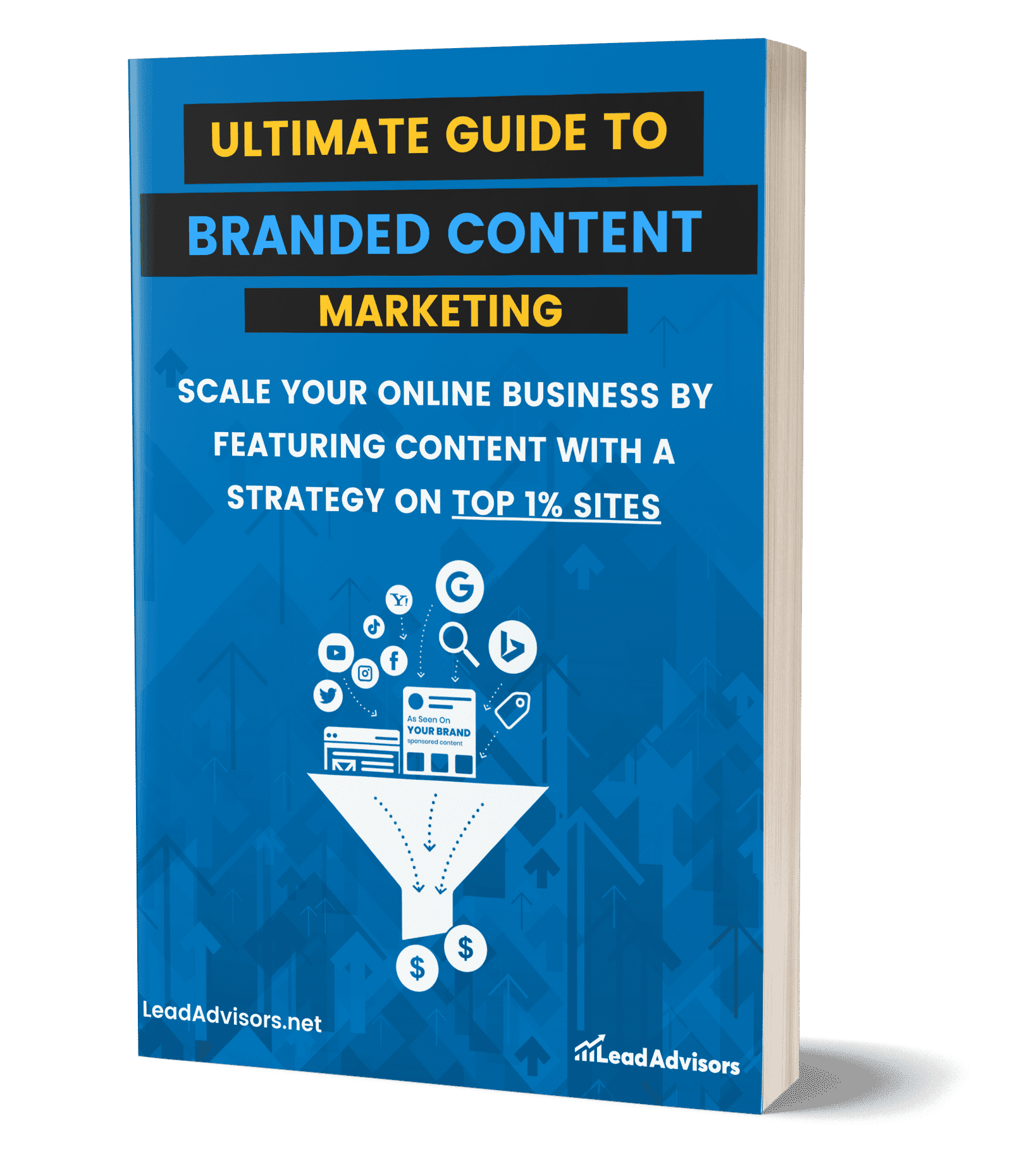If you’ve ever found yourself staring at a long list of keywords wondering, “How am I supposed to create content for all of these?” – you’re not alone. And here’s the thing: you don’t have to create a separate blog post for every single keyword. That’s where keyword clustering comes in.
Essentially, keyword clustering is the act of clustering similar keywords so you can examine them all in one single, cohesive block of content. It’s a more intelligent, strategic, and much more effective approach to trying to outrank one keyword at a time.
But why does this actually matter?
In this guide, I’ll walk you through the steps to becoming a keyword clustering master – from creating your keyword list to grouping them by search intent and applying them to produce content that actually ranks.
If you’re a solo blogger or responsible for SEO for a brand, this tactic should be in your toolkit.
Ready to turn your keyword chaos into a clear content strategy? Let’s dive in.
What is Keyword Clustering?

So, let’s break it down – what exactly is keyword clustering?
Keyword clustering is the process of grouping keywords that share similar meanings or search intent. Instead of writing separate blog posts for every single keyword variation, clustering helps you combine them into one well-optimized, super-helpful piece of content.
Here’s a quick example:
Say you have keywords like:
- “best running shoes for beginners”
- “top running shoes 2024”
- “affordable running shoes for new runners”
Rather than writing three separate articles, you’d cluster those keywords and create one guide that answers all of those search queries. Google picks up on that, sees your content as more complete, and often rewards it with better rankings across several keywords.
But why does it matter?
- Better keyword targeting – You can rank for a variety of search terms with just one piece of content.
- Less duplication – Say goodbye to writing multiple blogs that basically say the same thing.
- Stronger site structure – When your content is organized around keyword themes, it becomes easier for both users and search engines to navigate.
Keyword Clustering vs. Topic Clustering
Now, you might be thinking, Wait – how’s this different from topic clustering? Aren’t they the same thing?
They’re definitely related, but not quite the same. Here’s how they stack up:
| Aspect | Keyword Clustering | Topic Clustering |
| Focus | Groups closely related search terms | Groups content around a broad subject or theme |
| Goal | Improve keyword targeting and search visibility | Organize content into hubs and support pages |
| Structure | One page targets multiple related keywords | Multiple pages link to a pillar page (hub & spoke model) |
| Level of Strategy | Tactical (keyword-level) | Strategic (site-level or content marketing-level) |
| Example | Cluster: “running shoes,” “best-running sneakers,” “shoes for new runners” | Topic: “Running Gear” with related pages like shoes, socks, watches |
| SEO Benefit | Helps a single page rank for multiple terms | Builds topical authority and internal link structure |
The Big Picture
Think of keyword clustering as zooming in and fine-tuning your content for a specific page, while topic clustering zooms out to build a more significant, connected content strategy. When do you use both together? That’s when SEO magic happens.
Benefits of Keyword Clustering
Okay, now that we’ve covered what keyword clustering is, let’s talk about why it’s such a game-changer for your SEO strategy.
Spoiler alert: it’s not just about rankings – it’s also about saving time, creating better content, and making your site a joy to navigate.
Here are the key benefits of keyword clustering (with real-world examples to back it up):
Higher Visibility in SERPs
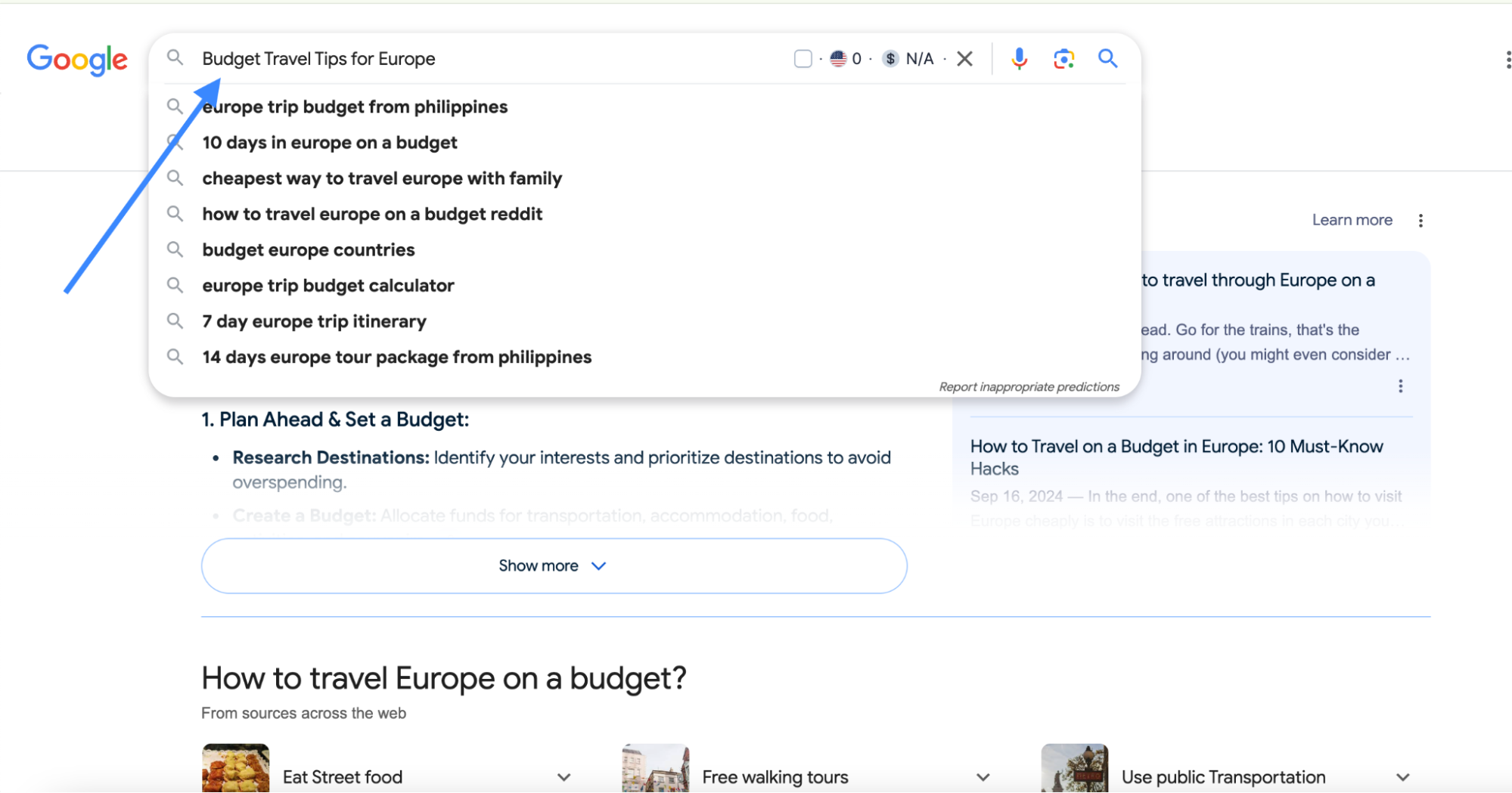
When you cluster keywords, you’re not just aiming to rank for one search term – you’re casting a wider net. By targeting multiple related keywords in one well-structured page, you boost your chances of showing up for several searches.
Example:
Let’s say you write a post titled “The Best Budget Travel Tips for Europe”. If you’ve clustered keywords like “cheap ways to travel Europe,” “budget Europe itinerary,” and “how to travel Europe on a budget,” you can rank for all of those, not just one.
Stronger Site Architecture
Keyword clusters naturally lead to better internal linking. When you group related content together and link them properly, search engines understand your site better – and users stay longer because everything just makes sense.
Example:
If you have a content hub about “Marketing Consultancy Film,” your keyword clusters can include posts on SEO, Content Marketing, Sales Funnels, E-Commerce, and many more. All those pieces can link back to the main hub and to each other. It’s clean, clear, and SEO-friendly.
More Efficient Content Creation
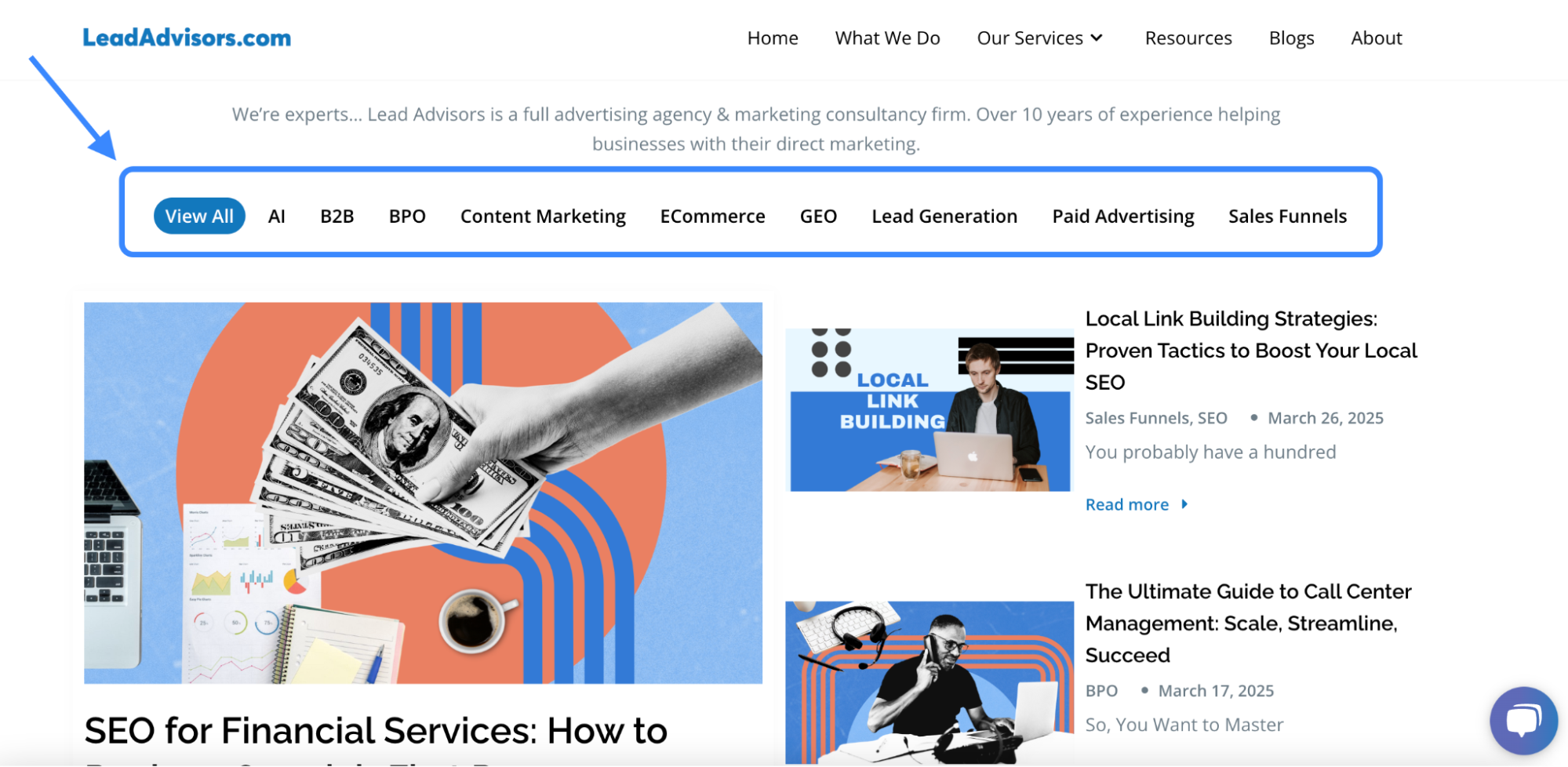
Ever feel like you’re writing the same blog post over and over again with slightly different titles? Keyword clustering eliminates that. By grouping similar keywords, you reduce repetitive content, and you can focus on creating one high-quality post and cornerstone content that hits all the marks.
Example:
Instead of three posts:
- “Top Laptops for College Students”
- “Affordable Laptops for Students”
“Best Student Laptops Under $1000”
…you cluster those keywords and write one epic guide.
Better User Experience
Clustering helps you cover a topic thoroughly, which means readers get everything they’re looking for in one place. No more bouncing between tabs or going back to Google for more info. Your content becomes the go-to.
Example:
Someone searching “how to start a podcast” will appreciate a guide that also touches on equipment, editing tools, marketing, and monetization – all in one post – rather than needing to find four separate articles.
Saves Time & Effort (Especially with Tools)
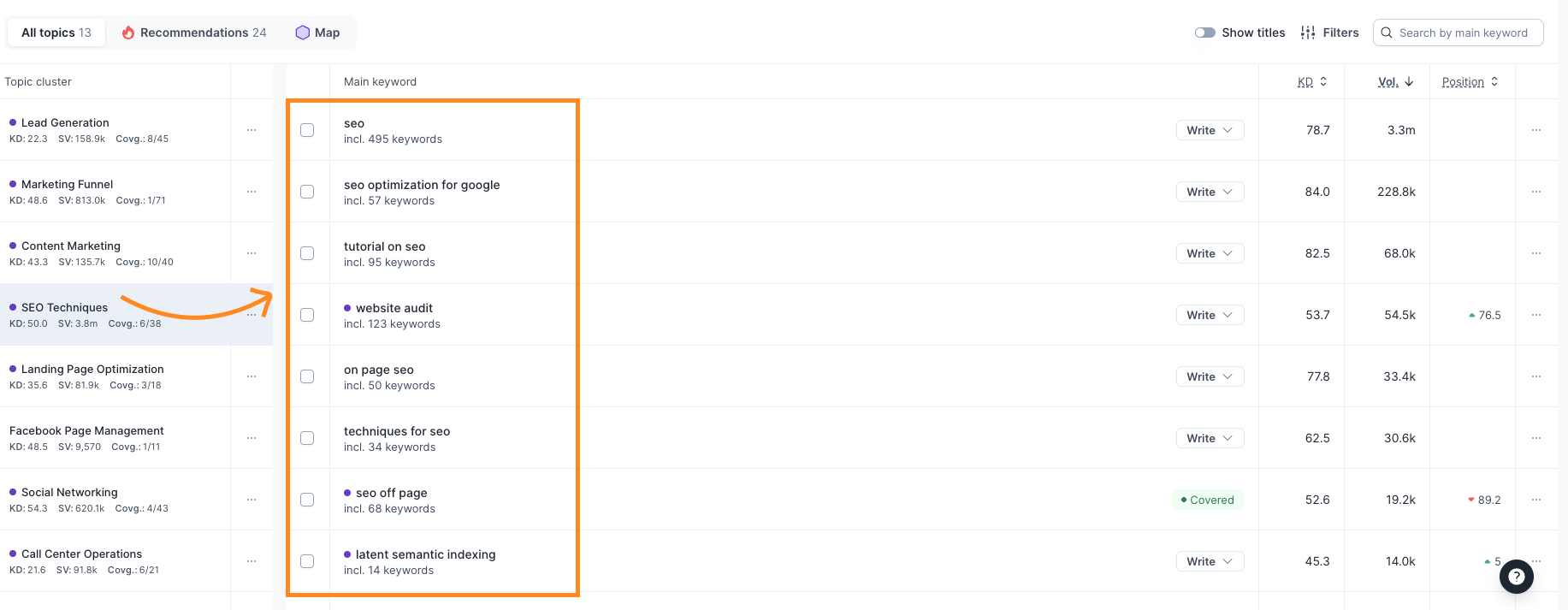
Manually organizing keywords can be a drag – but clustering tools like Keyword Insights or SurferSEO automate the heavy lifting. They analyze SERPs, group keywords by intent, and help you spot opportunities quickly.
Pro tip: Start with a bulk keyword list from a tool like Ahrefs or SEMrush, then feed it into a clustering tool for instant topic organization.
In short? Keyword clustering is like giving your content strategy a significant upgrade. It’s smarter, faster, and built for how search works now – not five years ago.
Manual vs. Automated Keyword Clustering
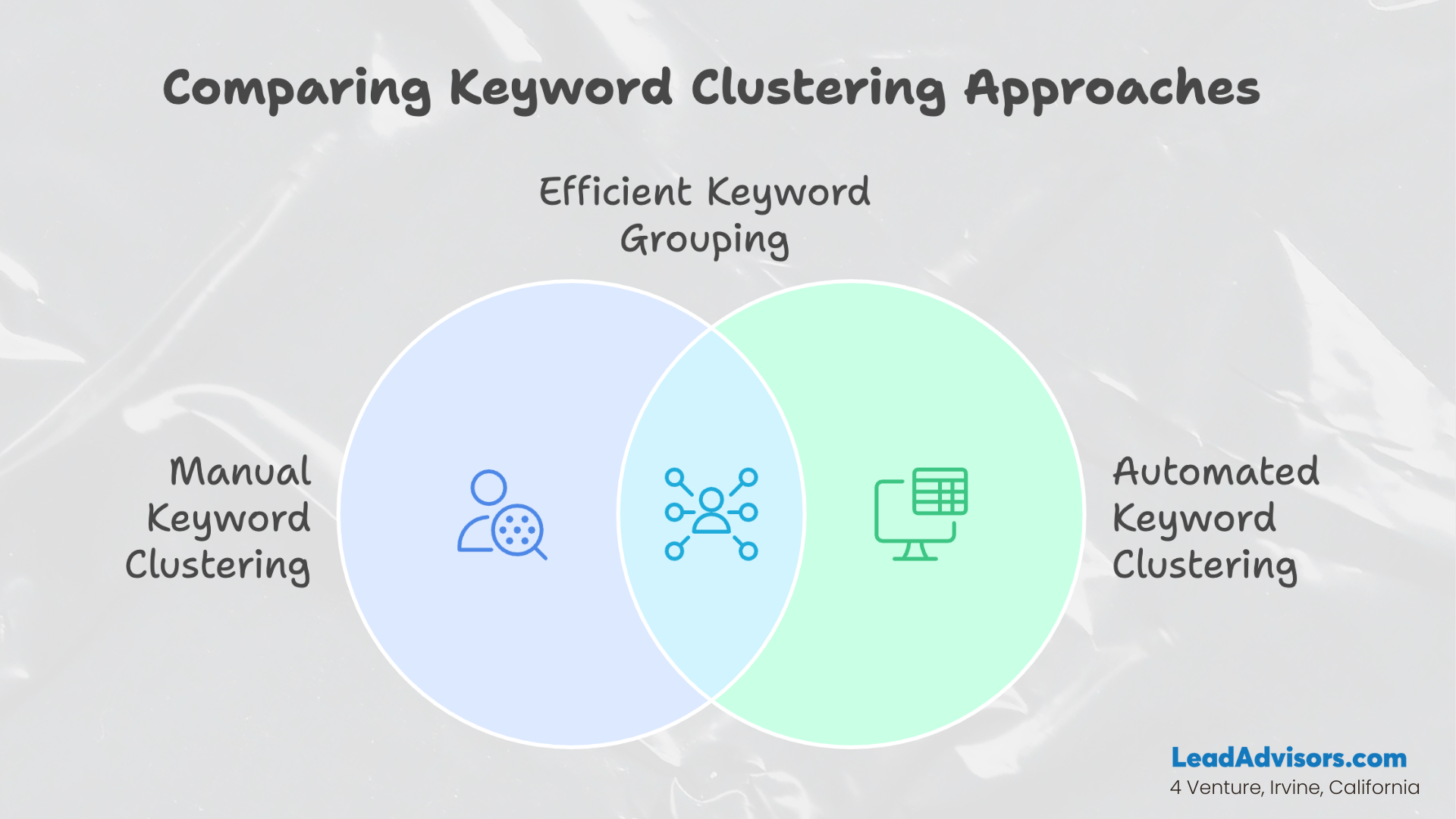
So you’re sold on keyword clustering – awesome. But now comes the big question: Should you do it manually or let a tool handle it for you?
Honestly, it depends on your workflow, how many keywords you’re dealing with, and how deep you want to go. Let’s break down both approaches so you can decide which best suits you.
Manual Keyword Clustering
Manual clustering means you’re rolling up your sleeves and grouping keywords yourself. You’ll look at things like:
- SERP results (Do the same pages rank for different keywords?)
Keyword similarity (Are they just word variations? - Search intent (Are people looking for the same kind of answer?)
Best for:
- Small-scale projects
- Niche topics
- Bloggers or solo marketers who love full control
Example:
If you’ve only got 50 keywords about “eco-friendly skincare,” you can manually Google a few terms, compare overlapping results, and cluster accordingly. It gives you better insights into user intent – and you’re not relying on a tool’s logic.
The downside?
It’s super time-consuming. Once your list gets into the hundreds or thousands, manual sorting feels like trying to untangle a box of Christmas lights. Not fun.
Automated Keyword Clustering
For more significant projects, automation is your best friend. Keyword clustering tools use algorithms – and often leverage Natural Language Processing (NLP) – to analyze keyword relationships, compare SERPs, and group terms by topic and intent – fast.
Best for:
- Large-scale content planning
- Optimizing new or growing websites
- Agencies, SEO teams, or anyone short on time
Here’s a quick rundown of popular tools and how they handle clustering:
| Tool | What It Does Best | Bonus Points |
| Semrush Keyword Strategy Builder | Builds clusters around a target keyword | Integrates with Semrush’s entire SEO toolkit |
| Ahrefs Parent Topic Grouping | Clusters keywords by their “parent topic” | Great for finding which page is most relevant |
| SE Ranking Keyword Grouping Tool | Groups keywords by URL overlap in SERPs | Ideal for bulk clustering + ranking data |
| Keyword Insights | Uses AI to cluster keywords by SERP similarity and intent | Super clean interface with content brief generator |
Pros & Cons
Here’s a quick side-by-side:
| Manual Clustering | Automated Clustering | |
| Pros | More control, a deeper understanding of search intent | Faster, scalable, time-saving |
| Cons | Slow, tedious, not scalable | Might misgroup some keywords, less flexible |
| Best Use | Small projects, niche content | Large projects, bulk content planning |
If you’re just getting started or working with a small keyword list, manual clustering is a great way to understand how it all works. But if you’re managing dozens of pages or scaling content across multiple categories? Trust me – automated tools will save your sanity.
How to Do Keyword Clustering (Step-by-Step)
Alright, now let’s get into the good stuff: how to actually cluster your keywords like a pro. Whether you’re doing this manually or with tools, this step-by-step guide will keep you focused and organized.
Step 1: Build a Solid Keyword List
First things first – you need keywords to cluster. Start with a big ol’ list. The more diverse, the better.
Where to find them:
- Keyword research tools like Semrush, Ahrefs, or Google Keyword Planner
- Use seed keywords (your core topics) to get the ball rolling
- For example, you used:
- iPhone
- Samsung Galaxy
- Google Pixel
- OnePlus
- Motorola
- For example, you used:
Once you’ve entered your seed terms, head over to a keyword ideas report. In Ahrefs, the Matching Terms report is an ideal place to start. It’ll show you all the keywords in their database that contain one or more of your seed terms – potentially millions of options. You can also run a quick content gap analysis to identify high-opportunity keywords your competitors rank for, but you haven’t targeted yet.
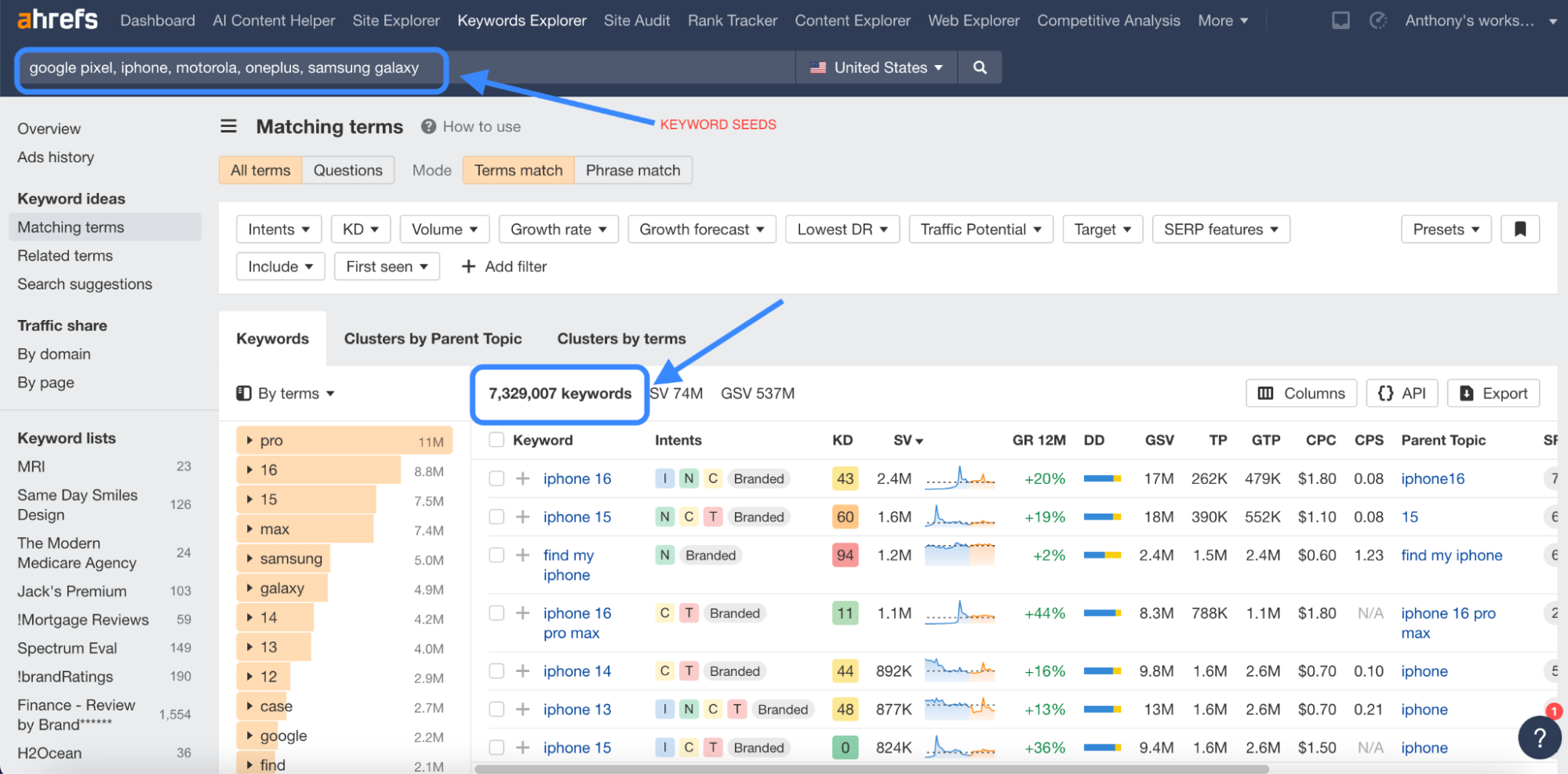
From there, you can work with the full keyword list or narrow it down to target more specific keyword clusters.
If you’re aiming for low-competition keywords, use filters like:
- Low Keyword Difficulty (KD): These tend to have fewer backlinks pointing to top-ranking pages, making it easier to rank.
- Low Domain Rating (DR) among top results: If websites with authority similar to yours are ranking, that’s a green light to go after those keywords.

If you’re running an affiliate site, try using the Include filter to find keywords that include terms like “best,” “review,” or “comparison” – these often signal buying intent.
Once you’ve got a hefty list, export everything into a spreadsheet. Keep it clean – include columns for keyword, search volume, difficulty, and intent (if you already know it). You’ll thank yourself later.
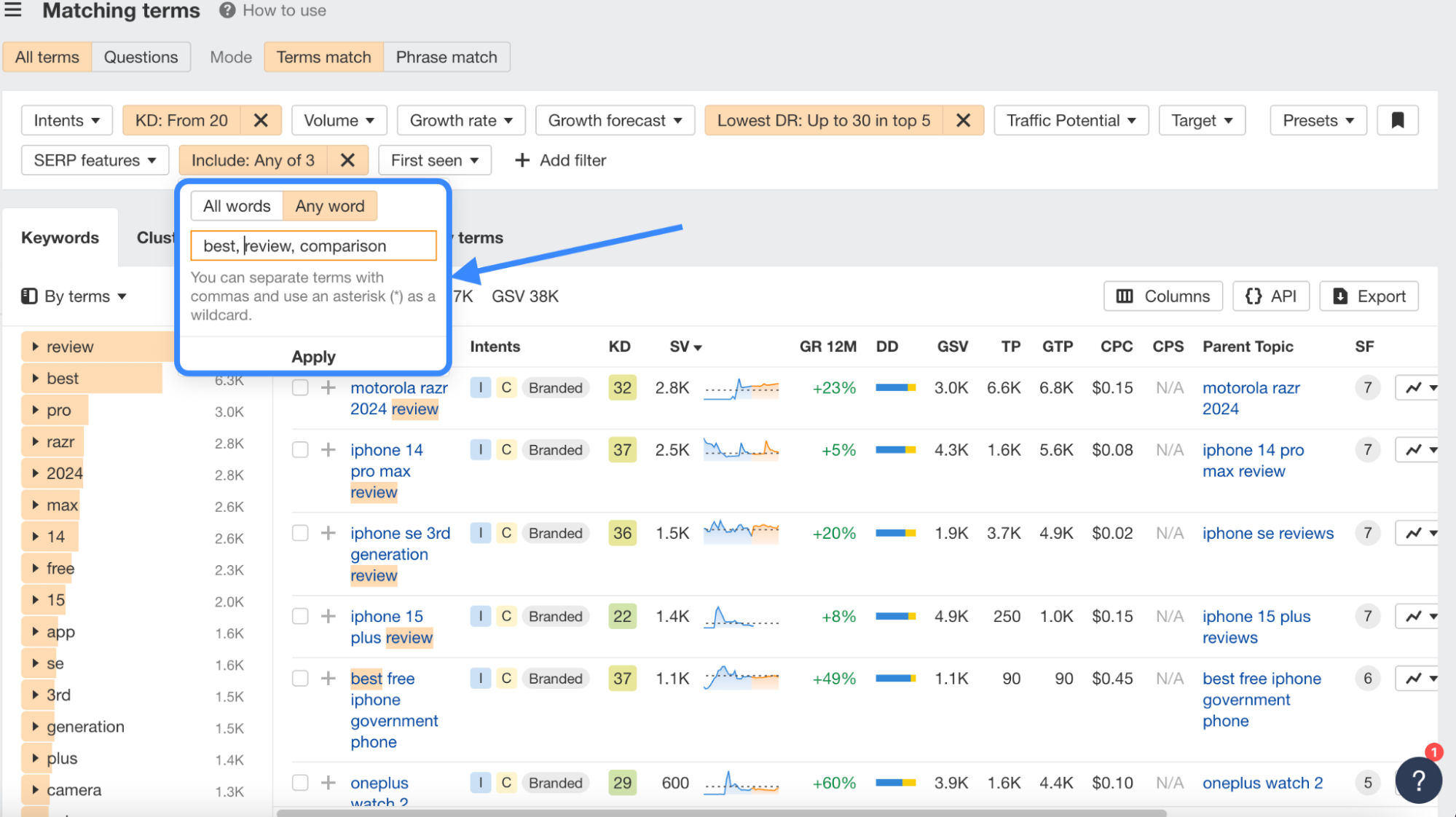
Step 2: Categorize Your Keywords by Intent
Now let’s get strategic. Not all keywords are created equal – some people want info, some are ready to buy, and others just want to compare options.
Identify search intent:
| Search Intent | Example |
| Informational | “how to choose a CRM” |
| Navigational | “HubSpot CRM login” |
| Commercial | “best CRM for small business” |
| Transactional | “buy HubSpot CRM plan” |
Sorting your keywords by intent helps you align them with the right kind of content (blog, product page, comparison guide, etc.).
Pro tip:
To efficiently group your keywords in Ahrefs, head to the “Clusters by Parent Topic” section. This feature organizes your keyword list into clusters based on their top-ranking search intent – no manual sorting is required.
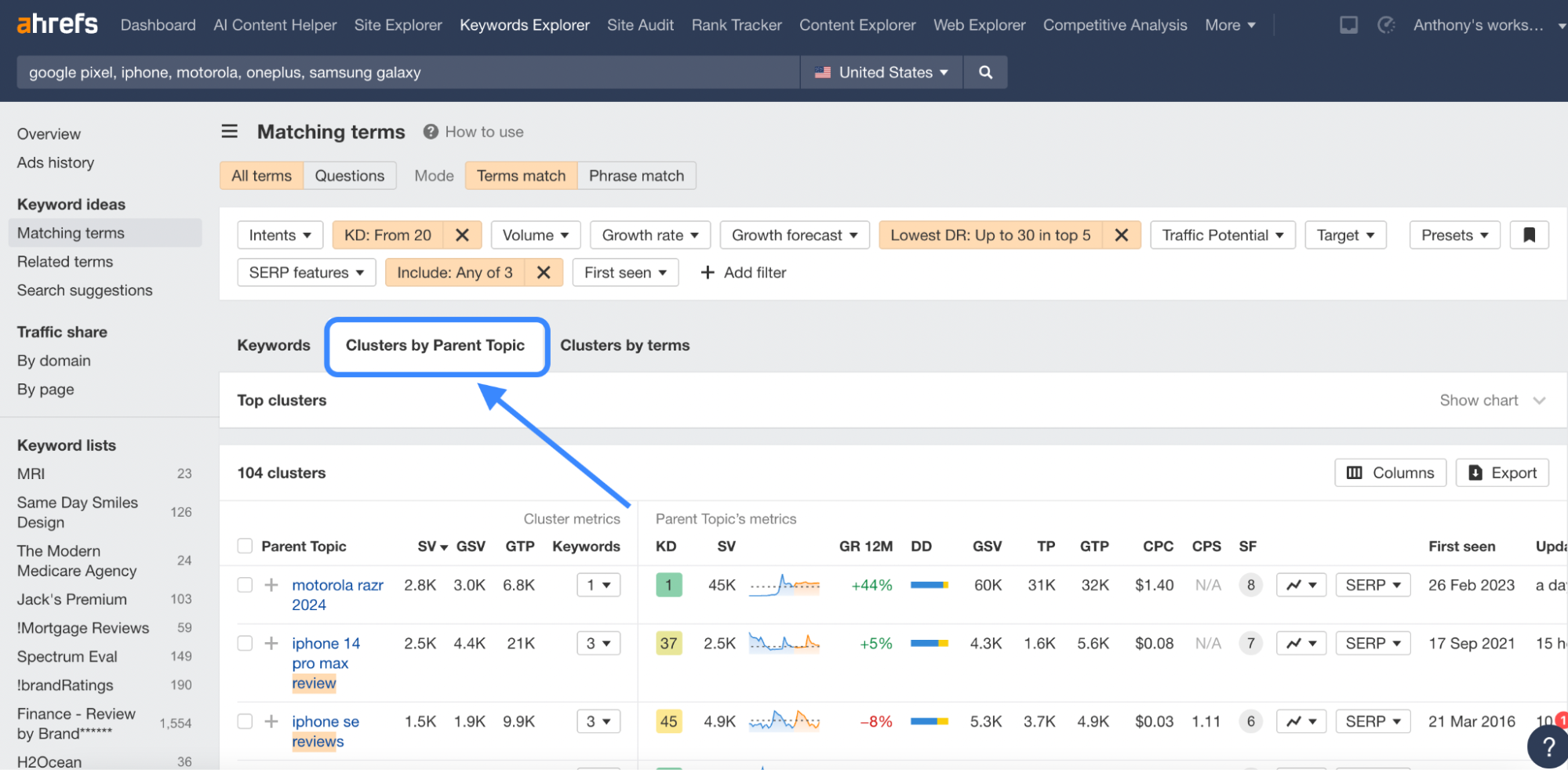
Each cluster displays combined search volume, along with key data points for the main keyword (the Parent Topic), such as its Keyword Difficulty (KD), monthly search volume, and Traffic Potential (TP).
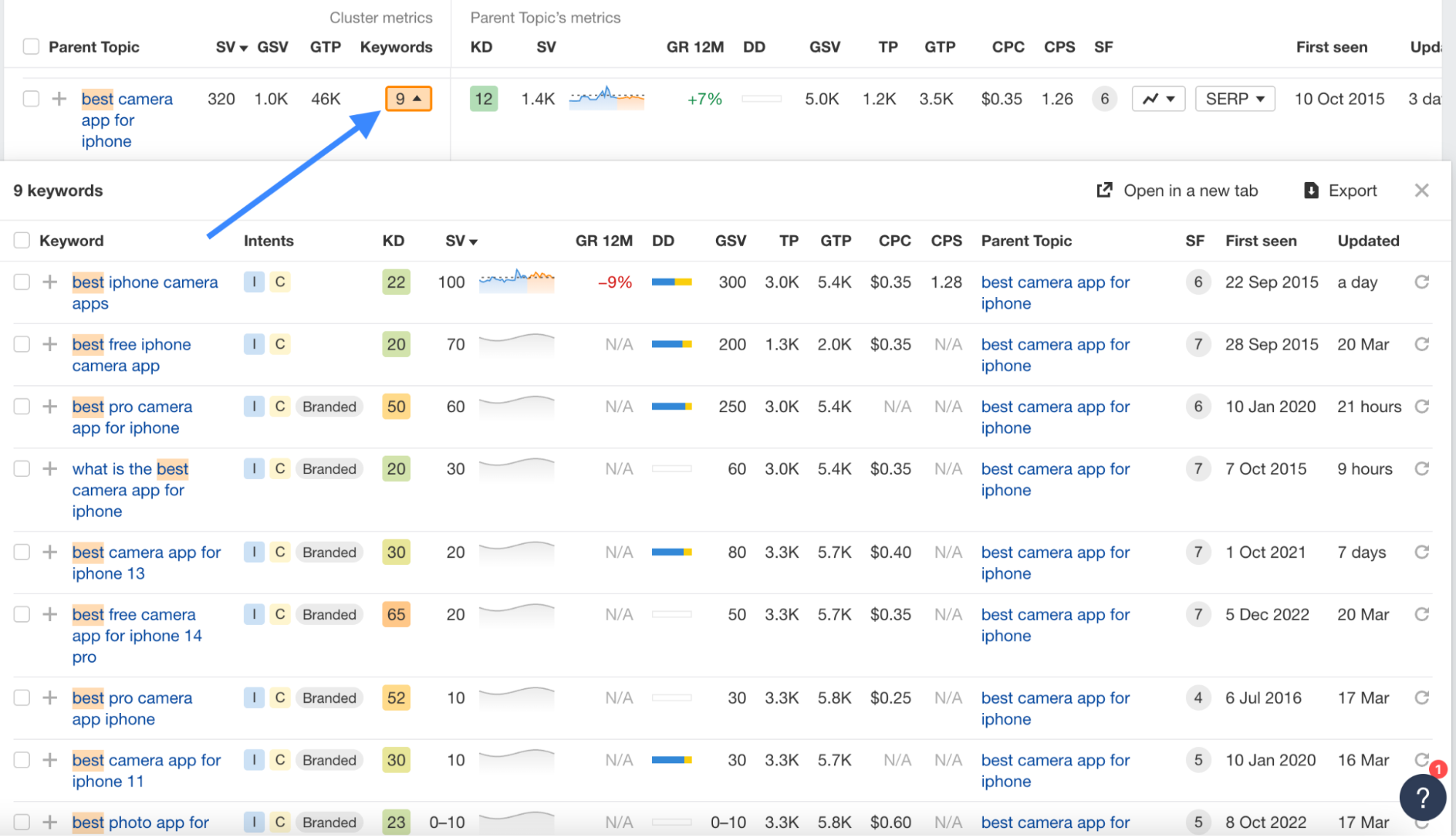
Step 3: Apply Clustering Techniques
Now comes the fun part: actually grouping your keywords.
There are a few techniques, depending on how deep you want to go:
SERP-Based Clustering
- Google your keywords and compare the top 10 results.
- If multiple keywords bring up similar URLs? Boom – they belong in the same cluster.
Semantic Keyword Clustering
- Some tools use AI to detect the meaning behind keywords, not just the words themselves. Helpful when keywords aren’t exact matches but have the same intent.
Soft vs. Hard Clustering
- Soft clustering: Looser groups. Good for broad, general topics.
- Hard clustering: Tighter, high-accuracy clusters. Ideal for focused content with a clear purpose.
Keyword Accuracy Levels:
- Want high precision? Use smaller clusters with tightly related keywords.
- Need speed and scale? Broader clusters work – but might require more editing down the line.
Step 4: Assign Keyword Clusters to Your Content Strategy
Now that your clusters are ready, it’s time to do keyword mapping on your content.
Here’s a simple rule:
One search intent = One keyword cluster = One optimized page
Examples:
- A “best CRM for freelancers” cluster = Blog post
- A “buy CRM software” cluster = Product page
- A “CRM software” cluster = Pillar page with links to more specific blog posts or comparisons
You can also align your keyword clusters with broader topic clusters by grouping related posts under a central pillar page – this is great for boosting your topical authority and internal linking game.
Step 5: Optimize Your Content Around the Clusters
You’ve done all the prep – now it’s time to bring your content to life.
On-page SEO tips:
- Primary keyword goes in your: Title, H1, meta description, and first paragraph.
- Secondary keywords should be sprinkled naturally throughout subheadings and body text.
- Internal links should connect related pages from the same or nearby clusters.
- Keyword stuffing? Big no-no. Write for humans first, search engines second.
Example:
Let’s say you’re writing a post titled “Best Budget CRMs for Freelancers in 2024”.
Your cluster might include:
- “budget CRM software”
- “freelancer CRM tools”
- “cheap CRM for solopreneurs”
Use the primary in your headline and intro, and let the rest flow naturally throughout the content.
Tracking & Optimizing Keyword Cluster Performance
Once you’ve taken the time to create keyword clusters and build content around them, the next step is tracking how they perform in real search results. This is where you turn your search engine optimization strategy from a one-time project into a long-term traffic booster.
Google Search Console Tracking
Start with Google Search Console – it’s the easiest way to see which pages are ranking for the keywords in your clusters. Head to the Performance tab and filter by page or keyword to identify which clusters are pulling in impressions and clicks.
You can also spot opportunities to improve by checking if the right page is ranking for the right keyword.
And don’t forget to watch out for keyword cannibalization – that’s when multiple pages compete for the same search intent, which can confuse Google and hurt your search engine rankings.
Using Rank Tracking Tools
For deeper, ongoing insights, use rank-tracking tools to monitor how your keyword clusters are performing. Semrush’s Position Tracking Tool is great for grouping your cluster keywords and tracking them together – perfect for content that targets 2–4 keywords.
Ahrefs’ Rank Tracker helps you track SERP shifts over time, making it easy to spot whether your page is climbing or slipping. And if you want to automate things a bit, SE Ranking’s Keyword Rank Tracker delivers daily updates and trend alerts so you don’t miss anything.
Adjusting Keyword Clusters Over Time
Keyword clusters aren’t meant to be static. Over time, you’ll want to re-cluster keywords based on changing search trends, new algorithm updates, or shifts in what users are really looking for.
For example, if you notice new questions popping up in People Also Ask, that’s a sign the search intent might be evolving. These changes can uncover new content opportunities, or highlight old content that needs a refresh to stay competitive.
Optimizing Underperforming Content
If a piece of content isn’t performing well – maybe it’s ranking for 0 out of 2–4 keywords in its cluster or not showing up in the top 50 at all – it’s time to take action.
Revisit the page, check alignment with its keyword cluster, and consider content pruning to remove or consolidate outdated or low-performing pages.
This could mean updating headlines, refining subtopics, improving internal linking, or adjusting your keyword usage to better match the intent. Sometimes a small tweak can give your search engine rankings the boost they need.
Advanced Keyword Clustering Strategies
Once you’ve got the fundamentals down, keyword clustering becomes more than just an SEO tactic – it becomes a creative tool. You can tailor your approach based on your content goals, whether you’re running an e-commerce site, serving a local audience, managing a blog, or scaling fast with AI.
For E-commerce Brands: Think Like a Shopper
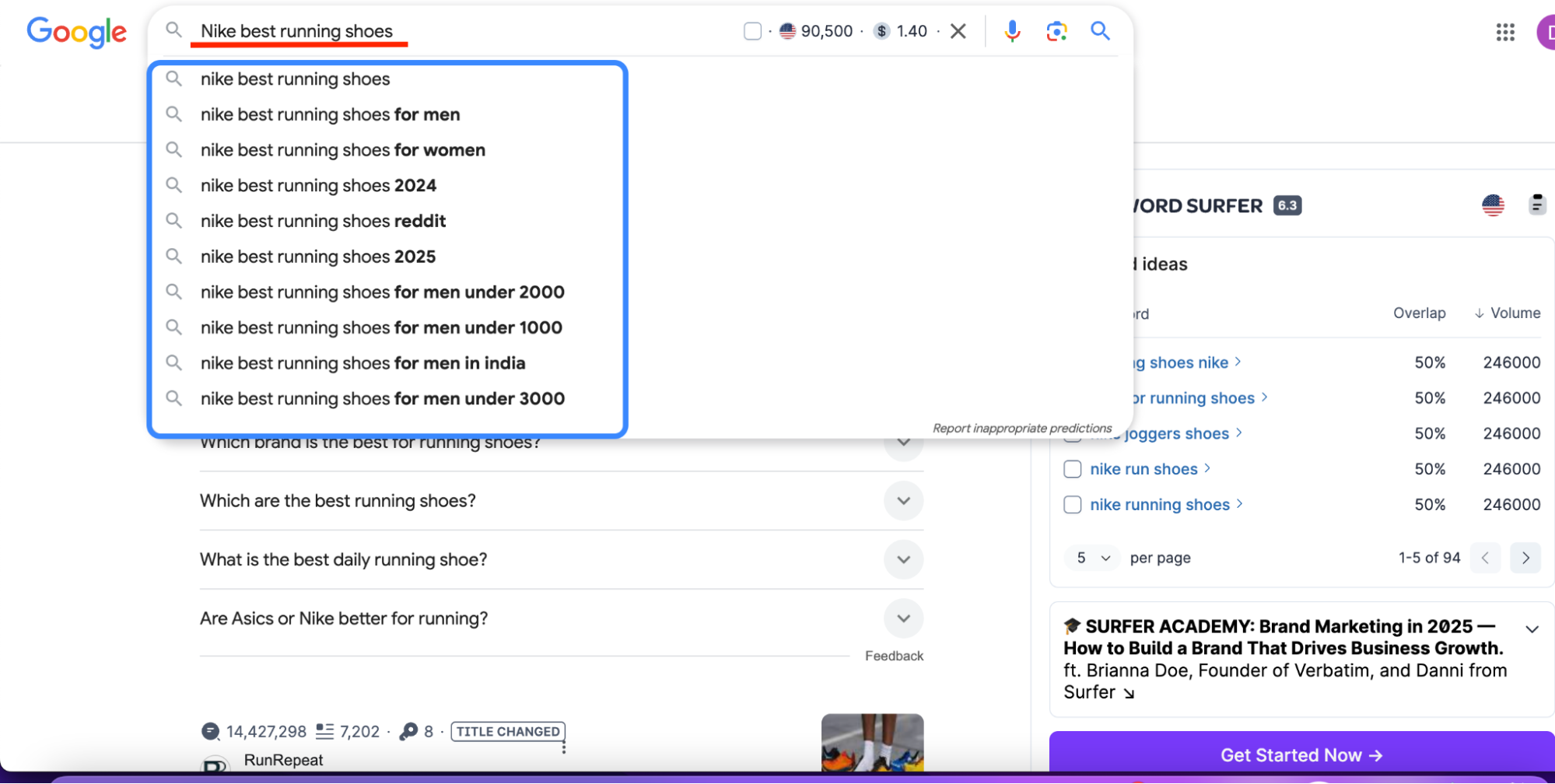
When you sell products online, people don’t just search for the item – they search based on need, brand, size, and situation.
Instead of writing separate product pages for every slight variation, create smart keyword clusters that match users’ shopping habits.
Example: Let’s say you’re selling running shoes:
- Core keyword: best running shoes
- Cluster variations:
➤ for flat feet
➤ for women
➤ Nike running shoes
➤ long-distance running shoes
These can be handled within one robust category page or guide, with smart filters, internal links, and buyer-specific messaging. The bonus? You reduce duplicate content while hitting multiple search engine rankings in one go.
For Local Businesses: Cover Every Corner of Your City
Local SEO is all about showing up where your customers are searching – and keyword clustering makes that easier.
Instead of just targeting “plumber in Los Angeles,” zoom in.
Build clusters like:
- emergency plumber LA
- 24-hour plumber in Los Angeles
- affordable plumbing near Downtown LA
- Hollywood pipe repair services
Now you’ve got the blueprint for multiple local landing pages – each tailored to a unique search intent, but all working together to boost your local authority.
Use consistent formats across these pages (testimonials, service lists, maps) so Google can crawl them easily and users get a seamless experience.
For Bloggers & Content Marketers: Build Content Ecosystems
Blogging with keyword clustering isn’t just about ranking – it’s about becoming the go-to resource in your niche.
Here’s how it plays out:
You write a long-form guide, say, “How to Start a Podcast.” Then you build mini-posts around it – the best podcast microphones, free editing tools for beginners, and how to upload to Spotify. Each of these comes from a different keyword cluster, but they’re all connected.
Link them together. Add a visual hub page. Create content paths that make sense to the reader. And suddenly, you’re not just answering one question – you’re answering them all. That builds trust, time on the page, and (yes) rankings.
For Teams Using AI: Go From Keyword Ideas to Execution in Minutes
When you’re managing hundreds of keywords, AI isn’t just helpful – it’s the secret weapon.
AI-powered clustering tools like Keyword Insights, Surfer AI, and even ChatGPT can process thousands of keywords, identify the same search intent terms, and output topic clusters within minutes.
What used to take hours of spreadsheet work now looks like this:
- Upload your list
- Get keyword groups, search volume, and SERP overlap
- Auto-generate blog outlines with titles, questions, and structure
Example:
A SaaS company could input a giant list like:
- CRM software for freelancers
- affordable CRM tools
- how to manage leads in CRM
The tool groups them under a high-intent cluster, suggests a topic like “Top CRMs for Solopreneurs in 2024,” and gives you a full outline. Just add your brand voice and hit publish.
Mix Strategies for Maximum Impact
Here’s where it gets fun – you don’t have to pick just one approach.
Let’s say you’re launching a new product line for your local business. You can:
- Use e-commerce clustering for product pages
- Layer in local keyword clusters for nearby cities
Build a blog content plan around common questions - Use AI tools to speed up your research
The real value comes from combining these strategies and customizing them to your business model. That’s when you stop writing for keywords – and start writing for visibility, traffic, and conversions.
Recommended Tools & Resources
Want to make keyword clustering smoother and smarter? Here’s a go-to list of tools to help with clustering, tracking, and optimizing your content – broken down by category:
| Tool Category | Tool | What It Does |
| Keyword Clustering | Semrush Keyword Strategy Builder | Clusters keywords based on SERP overlap and intent |
| Ahrefs Parent Topic Clustering | Automatically groups keywords under a broader parent topic | |
| SE Ranking Keyword Grouping Tool | Uses SERP similarity to cluster-related keywords | |
| Keyword Insights | AI-powered keyword clustering with intent detection and content brief features | |
| Keyword Tracking | Google Search Console | Tracks keyword impressions, clicks, and cannibalization |
| Semrush Position Tracking | Monitors keyword cluster rankings across devices and locations | |
| Ahrefs Rank Tracker | Tracks SERP positions and keyword movements over time | |
| Content Optimization | Surfer SEO | AI-assisted content optimization based on keyword clusters and SERP data |
| Frase.io | Builds semantically optimized content briefs around keyword clusters | |
| Jasper AI | AI-powered content generation aligned with your keyword and topic clusters |
These tools work even better together. For example, you can cluster with Keyword Insights, track with Semrush, and optimize with Surfer SEO – all without losing your focus on search intent and search engine optimization.
Let me know if you’re ready for the Conclusion or want a downloadable version of the table!
Frequently Asked Questions
Can keyword clustering improve the visibility of older web pages?
What’s the difference between grouping search terms manually and using a free keyword grouping tool?
How often should I update my keyword clusters for live web pages?
Can I use keyword clustering for non-blog content like product pages or service landing pages?
Are there any completely free keyword grouping tools I can start with?
Mastering Keyword Clustering for Smarter SEO
Keyword clustering turns keyword chaos into a clear, actionable content strategy. Instead of creating a separate post for every term, you group related keywords by search intent, target multiple phrases on one page and build content that’s both efficient and powerful.
It helps you:
- Rank for more keywords with less content
- Strengthen your site structure
- Improve user experience
- Save time with smarter planning and tools
Whether you’re a solo creator or scaling content for a brand, keyword clustering is your shortcut to better search engine rankings and content that actually performs.
Now that you’ve got the steps, tools, and strategies—go cluster with confidence.




